

Tagged: anarchism, biography, economic history, immigration, labor, political history, Progressive Era, socialism, women's history
By Kollin Fields
May 31, 2022
“…I tell you that I hate your laws [and] your ‘order,’ for I know but one ‘order’—it is the highest potency of order—Anarchy.”
~Emma Goldman, 1893
“Murderous Emma Goldman, will burn in hell-fire for your treachery to our country.”
~Letter to Emma Goldman after the assassination of William McKinley
“In the United States, law is an imperishable thing, and for such people as would nullify our laws we have no place in our country. In a case such as this I can but inflict the maximum sentence which is permitted by our laws.”
~United States vs. Emma Goldman, 1917
Between contested elections and global crises, seemingly every political issue today is seen as a “threat to our democracy.” But despite the general consensus on the desirability of democracy in the West, this system of the people and by the people has not been without its detractors. A century ago, the Russian-born anarchist, Emma Goldman (1869-1940), was the embodiment of a threat to American democracy. Her motto was “Death to Tyranny! Vive l’Anarchie!”[1] As an anarchist, Goldman was against all forms of political authority, and for this she drew the ire not only of the American government, but of her native Russia as well. On trial in 1917 for encouraging Americans to refuse conscription, the prosecutor told the jury, “If you could see Emma Goldman at her meetings, you would realize that she is a menace to our well-ordered institutions.” And before handing down her prison sentence and eventual expulsion to Russia, the judge decreed, “In the United States, law is an imperishable thing, and for such people as would nullify our laws we have no place in our country.”[2] Goldman’s opposition to the American government poses an interesting question for our modern democracy: is there room for radical dissent?
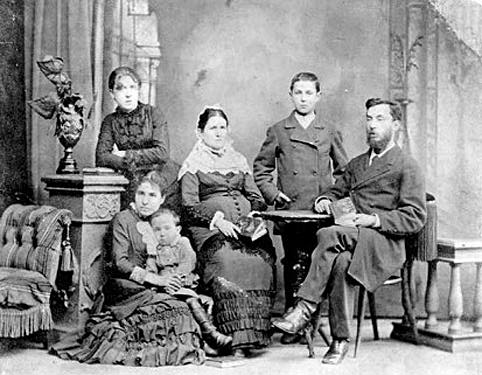
Emma Goldman’s family in St. Petersburg, Russia, 1882. Left to right: Emma (standing), older half-sister Helena, younger brother Moishe/Morris, mother Taube, younger brother Herman, and father Abraham.
Goldman was born in the Tsarist Empire in 1869, the daughter of Jewish inn-keepers, and moved with the family to St. Petersburg when Goldman was thirteen. It was in St. Petersburg that the teenage Goldman became steeped in the revolutionary fervor of Russian radicals—socialists and anarchists who opposed exploitation in all its forms, whether political or economic. Goldman emigrated to New York in 1885 and worked first at a coat factory and later as a nurse. In America, Goldman became a fierce advocate for free speech, birth control, and free love, all of which were grounds for censure in the post-Victorian cultural climate of the Progressive Era. She opposed anything and everything that she saw as oppressing the individual, “the fountain-head of all life and all values,” as she put it.[3] In America, this meant political democracy itself was the enemy, and unapologetically saying so was what made Goldman seem uniquely dangerous to her critics.
In reassessing her views on democracy, Goldman teaches us about the limits of our own political system today, and whether or not we can abide dangerous ideas. If liberal democracy is predicated on equality and, as James Kloppenberg writes, the Ethic of Reciprocity, is there equal space not only for dissent but for direct opposition? Can pluralistic notions of The Good make room for those who undermine the legitimacy of the democratic system as a whole? In Goldman’s case, it was not even so much the bad things she did, as much as it was the dangerous things she thought and said. For her radical rhetoric, J. Edgar Hoover even called her “most dangerous woman in America.”[4]
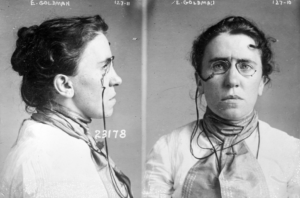
Emma Goldman’s mugshot in 1901 when she was wrongly implicated in the assassination of President William McKinley.
At the dawn of a new century, political democracy was expanding, at least in theory, and American intellectuals were fixated on words like “progress,” “new,” and “social.” “Social democracy,” as espoused by the likes of John Dewey, Jane Addams, and other American liberals, was an imaginative enterprise that brought equality into the spheres of economics and culture. For Addams, this meant taking reform where it was actually needed: into the ethnic slums and working-class neighborhoods of Gilded Age America. Addams’s famed Hull House in Chicago was similarly an attempt to democratize culture, offering vocational training and artistic opportunities to the lower classes. And Dewey, the quintessential educational theorist of the early twentieth century, aimed at educational reform intended to pragmatically train students for life as democratic citizens. This class of liberal reformers envisioned democracy as all-encompassing, equally social as it was political. But while Goldman agreed with the egalitarian ends of liberals in society and the economy, she adamantly opposed democratic governance, as she opposed all governments.
Goldman commentators have deftly navigated the contours of her thought on anarchism, education, sexual equality, and political violence, but her political philosophy takes on a new light when we consider its implications within the specific context of America’s Progressive Era. The years between 1900-1920 are often framed by historians as a fight for political democracy at home and abroad, championed by progressive liberals who perceived the state as an untapped resource in the fight for equality. By 1917, the Wilsonians were so sure of their mission that they could plunge headfirst in a war to “make the world safe for democracy.” But Goldman’s critique of American political democracy—that is, liberal democracy—was that it was the most insidious of political forms since it operates through the guise of equality and genuine participation among the masses.
But unlike the liberal intellectuals of the Progressive Era, Goldman did not think political democracy could be reformed. Unlike Addams and Dewey, who both spoke of curing the ills of democracy with more democracy, Goldman asserted that it was the problem, not the solution. In the abstract, Goldman and liberal reformers both envisioned a more just and equal society, but she did not see American democracy as the pathway to this “beautiful ideal,” and for this was relegated in her own time to the fringes of political and economic thought, cast out of the corridors of respectable liberalism and painted as an avatar of extremism.[5] On the eve of her deportation to the Soviet Union in 1919, the state’s prosecutor labeled Goldman “a menace to our well-ordered institutions,” and the judge asserted that “we regard as enemies . . . those who counsel disobedience to our laws by those of minds less strong.”[6] Emma Goldman was therefore a threat to democracy at a time when America was trying to make the entire world safe for that most vaunted of political forms.
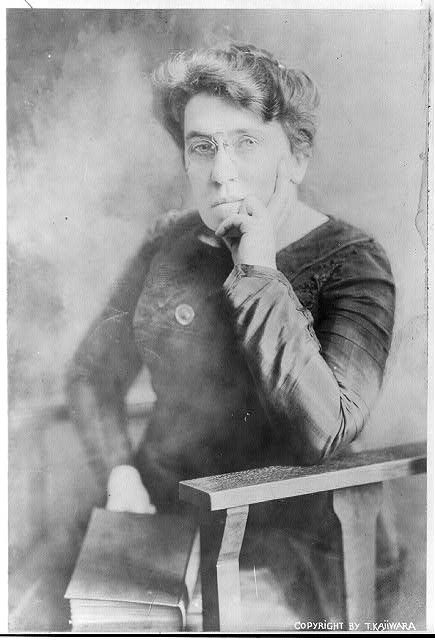
Portrait of Emma Goldman, ca. 1911. By T. Kajiwara. Library of Congress Prints and Photographs Division.
Although Goldman championed many of the same causes as American liberals—workers’ rights, anti-capitalism, and individual freedom—she would have none of what she called the “soup kitchen philanthropy” of Addams or other middle-class reformers.[7] She always perceived her means and ends as far more radical than that of American progressives and thought they were a hindrance to the ideal of true freedom. These “intellectual proletarians,” as Goldman referred to activist-liberals, were in reality not so radical, and she perceived their ends as generally in-line with the “bourgeois regime.”[8] While liberal progressives pushed for legislative action against child labor, unsafe working conditions, and political corruption, Goldman’s argument was that in pursuing remedies through democratic processes, these reformers were serving only to bolster the power of the State.
At times, it could seem that Goldman’s anarchism led her to be against more than she was for. She opposed capitalism, religion, and the State most of all, since it reinforced the social and economic arrangement that enslaved individuals. She wrote in “Anarchism: What It Really Stands For” that, “Religion, the dominion of the human mind; Property, the dominion of human needs; and the Government, the dominion of human conduct, represent the stronghold of man’s enslavement and all the horrors it entails.”[9] Despite her contrarianism, Goldman did articulate a vision for a world devoid of State-sponsored violence, militarism, and hierarchical economic relations. At times she spoke of an ideal “free communism,” and outlined her version of anarchist-syndicalism in which people are free to pursue their passions without the hegemonic control of a capitalist class.[10] Her true belief was in a natural harmony inherent to humanity, but, as she argued, this harmony is disrupted through the force of governments. Anarchism, according to Goldman, would not result in chaos, but rather a natural form of cooperation and organization, a “beautiful ideal.” She writes, “the Anarchists are therefore justified in assuming that Anarchism—the absence of government—will insure the widest and greatest scope for unhampered human development, the cornerstone of true social progress and harmony.”[11]
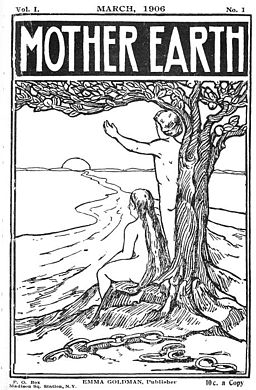
The first issue of Goldman’s anarchist magazine, Mother Earth, 1906.
Like most “individualist anarchists” in America, and even some classical liberal critics, Goldman perceived democracy as a political ruse that used taxation and economic exploitation to steal from the masses while enriching elite political and capitalist classes. She would have agreed with William Graham Sumner’s characterization that democracy is when “A and B decide what C shall do for D.”[12] However, unlike Sumner, Henry Adams, or other conservative contemporaries, Goldman’s antidemocracy did not stem from elitism or aristocratic cultural values.[13] On the contrary, Goldman did not think the masses were unworthy of democracy, but that democracy did not actually liberate the masses. In this way, her criticism of liberal democracy in America comes from a place of extreme egalitarianism. All of the industrial and political problems she witnessed around her—working conditions, corruption, censorship—antagonized the otherwise natural harmony inherent to mankind. “The organized activity of free human beings endowed with the spirit of solidarity [will] result in the perfection of social harmony,” she wrote in one of her more famous essays, “What I Believe.”[14] Political democracy, then, even the expanding democracy of the twentieth century, was not a step toward human liberation, but an impediment to social and economic freedom.
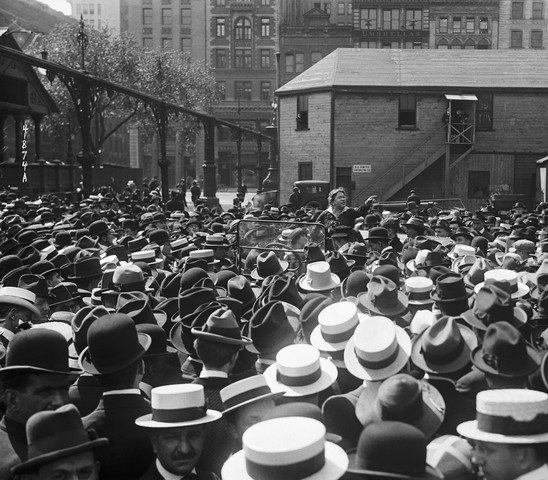
Emma Goldman addressing a crowd at Union Square Park, New York, 1916.
It is not difficult to see why Emma Goldman was considered dangerous. If political democracy is predicated on a plurality of competing views and opinions, how does it maintain stability against a theory like anarchism which opposes it as a way of life altogether? Part of what Goldman’s thought exposes are the limits of liberalism, and how we make room—indeed, if we can make room—for antidemocracy within a democracy. A paradox of liberal democracy, for both Goldman’s time and our own, is that while it nominally makes room for deliberation and reciprocity, it ultimately rests on the obedience of the governed and their deference to the State. As the judge in Goldman’s case from 1917 made clear, those who “counsel disobedience” are generally regarded as enemies of democracy. But how do we reconcile this with the basic tenets of liberal democracy such as free speech and freedom of conscience? Perhaps, like Dewey and Addams proposed, the solution is in the question, and we seek redress from democracy’s flaws through democratic action; though of course, Goldman disagreed. Ultimately, Goldman’s challenge to liberal democracy in America suggests to us that dissent can be healthy, and it helps us consider the fragile nature of our own democracy today.
Kollin Fields is an Assistant Professor of History at Greenville University and a doctoral candidate in the History of Ideas at the University of Texas-Dallas. His dissertation explores anti-democratic thought in America since the Civil War. His previous published work focuses on the cultural and political thought of American intellectuals predominantly in the twentieth century.
Cover Image: Emma Goldman’s mugshot in 1901 when she was wrongly implicated in the assassination of President William McKinley. Wikimedia Commons.
[1] Vivian Gornick, Emma Goldman: Revolution as a Way of Life (New Haven: Yale University Press: 2011), 38.
[2] Emma Goldman, Living My Life, vol. II (New York: Dover Publications, 1970 [1934]), 620-22.
[3] Emma Goldman, “The Individual, Society, and the State,” in Red Emma Speaks: An Emma Goldman Reader, Third ed., ed. Alix Kates Shulman (Amherst, NY: Humanity Books, 1998), 111-12.
[4] Gornick, Emma Goldman, 29.
[5] See Emma Goldman, Living My Life, vol. I (New York: Dover Publications, 1970 [1931]), 56.
[6] Goldman, Living My Life, vol. II, 620-22.
[7] The reference is specifically to Jane Addams, in Emma Goldman, “A Sentimental Journey,” Mother Earth (April 1906), in Emma Goldman: A Documentary History of the American Years, vol. II: Making Speech Free, 1902-1909, ed. Candace Falk (Berkeley: University of California Press, 2003), 186.
[8] See Emma Goldman, “Intellectual Proletarians,” in Red Emma Speaks.
[9] Emma Goldman, “Anarchism: What It Really Stands For,” in Red Emma Speaks, 66.
[10] See Emma Golmdna, “Syndicalism: Its Theory and Practice,” in Red Emma Speaks.
[11] Emma Goldman, “What I Believe,” in Red Emma Speaks, 51.
[12] William Graham Sumner, What Social Classes Owe To Each Other (New York: Harper & Brothers Publishers, 1883), 23.
[13] Though thinkers like Sumner and Henry Adams would have seen their views as classically liberal—in the European sense—the idea of the minimal state came to be seen as a conservative cause by midcentury.
[14] Goldman, “What I Believe,” 60.
Receive a year's subscription to our quarterly SHGAPE journal.